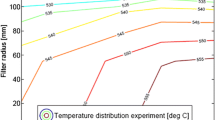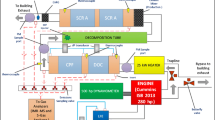Abstract
A multi-zone particulate filter (MPF) model was developed to predict pressure drop and PM oxidation of a catalyzed diesel particulate filter (CPF). The MPF model builds upon our previous work (Mahadevan et al., J Emiss Control Sci Technol 1:183–202, 2015; Mahadevan et al., J Emiss Control Sci Technol 1:255–283, 2015) by adding a new multi-zone version of a classical 1-D filtration model (Konstandopoulos and Johnson, 1989) to account for PM filtration within the substrate wall and PM cake of a CPF. In addition, pressure drop (∆P) simulation capability was also developed for the MPF model in order to simulate the pressure drop across the substrate wall and PM cake of the CPF. A cake permeability model was developed based on fundamental research findings in the literature. The PM cake and wall pressure drop simulation accounts for the wall and cake permeability variation during loading, PM oxidation, and an additional post-loading after oxidation. This extended MPF model was calibrated using 18 runs of experimental data from a Cummins ISL engine that consisted of passive and active regeneration data sets for ULSD, B10, and B20 fuels. The validation results show that the new MPF model can predict PM loading with a maximum root mean square (RMS) error of 7.4% and predict (∆P) across the filter with an RMS error of within 7.2%. It is found that the permeability of the PM cake layer increases rapidly during PM oxidation. The increase in permeability was attributed to the damage in the PM cake and was simulated using the newly developed cake permeability model. The increased permeability of the damaged PM cake layer and oxidation of cake PM leads to near zero cake PM pressure drop during PM oxidation for the passive and active regeneration experiments.





























Similar content being viewed by others
Abbreviations
- AR:
-
Active regeneration
- B10:
-
Diesel blend (ULSD) with 10% biodiesel
- B20:
-
Diesel blend (ULSD) with 20% biodiesel
- CPF:
-
Catalyzed particulate filter
- CO2 :
-
Carbon dioxide
- DOC:
-
Diesel oxidation catalyst
- DPF:
-
Diesel particulate filter
- ECU:
-
Electronic control unit
- HC:
-
Hydrocarbons
- MPF:
-
Multi-zone particulate filter
- MTU:
-
Michigan Technological University
- NO2 :
-
Nitrogen dioxide
- NO:
-
Nitrogen monoxide
- O2 :
-
Oxygen
- OBD:
-
On-board diagnostics
- PO:
-
Passive oxidation
- PM:
-
Particulate matter
- RMS:
-
Root mean square
- RU:
-
Ramp up
- SCR:
-
Selective catalytic reduction
- ULSD:
-
Ultra-low-sulfur diesel
- ∆P:
-
Pressure drop
- 1-D:
-
One-dimensional
- 3-D:
-
Three-dimensional
References
Raghavan, K.G.: An experimental investigation into the effect of NO2 and temperature on the passive oxidation and active regeneration of particulate matter in a diesel particulate filter, Master’s Thesis, Michigan Technological University (2015)
Mahadevan, B.S., Johnson, J.H., Shahbakhti, M.: Development of a catalyzed diesel particulate filter multi-zone model for simulation of axial and radial substrate temperature and particulate matter distribution. Journal of Emiss. Control Sci. Technol. 1, 183–202 (2015). doi:10.1007/s40825-015-0015-x
Mahadevan, B.S., Johnson, J.H., Shahbakhti, M.: Experimental and simulation analysis of temperature and particulate matter distribution for a catalyzed diesel particulate filter. Journal of Emiss. Control. Sci. Technol. 1, 255–283 (2015). doi:10.1007/s40825-015-0022-y
Konstandopoulos, A., Johnson, J.: Wall-flow diesel particulate filters—their pressure drop and collection efficiency, SAE Technical Paper 890405, (1989). doi:10.4271/890405
Shiel, K.L., Naber, J., Johnson, J.H., Hutton, C.R.: Catalyzed particulate filter passive oxidation study with ULSD and biodiesel blended fuel, SAE Technical Paper No. 2012–01-0837 (2012). doi:10.4271/2012-01-0837
Pidgeon, J., Naber, D N., Johnson, J.H.: An engine experimental investigation into the effects of biodiesel blends on particulate matter oxidation in a catalyzed particulate filter during active regeneration, SAE Technical Paper No. 2013-01-0521, (2013)
Shiel, K.L.: Study of the effect of biodiesel fuel on passive oxidation in a catalyzed filter. Master’s Thesis, Michigan Technological University (2012)
Pidgeon, J.: An experimental investigation into the effect of biodiesel blends on particulate matter oxidation in a catalyzed particulate filter during active regeneration. Master’s Thesis, Michigan Technological University (2013)
Kladopoulou, E.V., Yang, S.L., Johnson, H.J., Parker, G.G.: A study describing the performance of diesel particulate filters during loading and regeneration—a lumped parameter model for control applications, SAE Technical Paper No. 2003-01-0842, (2003)
Haralampous, O.A., Kandylas, I.P., Koltasakis, G.C., Samaras, Z.C.: Diesel particulate filter pressure drop. Part 1: modeling and experimental validation. Int. J.Engine Res. 5(2), 149–162 (2004)
Haralampous, O.A., Kandylas, I.P., Koltasakis, G.C., Samaras, Z.C.: Diesel particulate filter pressure drop. Part 2: on-board calculation of soot loading. Int.J.Engine Res. 5(2), 163–173 (2004)
Premchand, K.C.: Development of a 1-D catalyzed diesel particulate filter for simulation of the performance and the oxidation of particulate matter and nitrogen oxides using passive oxidation and active regeneration engine experimental data, PhD Dissertation, Michigan Technological University, (2013)
Premchand, K.C., Surenahalli, H., Johnson, J.: Particulate matter and nitrogen oxides kinetics based on engine experimental data for a catalyzed diesel particulate filter, SAE Technical Paper No. 2014-01-1553 (2014). doi:10.4271/2014-01-1553
Pulkrabek, W.W., Ibele, W.E.: The effect of temperature on the permeability of the porous material. Int. J. Heat and Mass Transfer. 30(6), 1103–1109 (1987)
Versaevel, P., Colas, H., Rigaudeau, C., Noirot, R., Koltsakis, G.C., Stamatelos, A.M.: Some empirical observations on diesel particulate filter modeling and comparison between simulation and experiments. SAE Paper No. 2000-01-0477, (2000)
Konstandopoulos, A.G., Kostoglou, M., Vlachos, N., Kladopoulou, E.: Advances in the science and technology of diesel particulate filter simulation. Adv. Chem. Eng. 33, 213–275 (2007)
Daido, S., Takagi, N.: Visualization of the PM deposition and oxidation behavior inside the DPF wall, SAE Technical Paper No. 2009-01-1473 (2009)
Choi, S., Lee, K.: Detailed investigation of soot deposition and oxidation characteristics in a diesel particulate filter using optical visualization, SAE Technical Paper No. 2013-01-0528 (2013). doi: 10.4271/2013-01-0528
Shadman, F.: Kinetics of soot combustion during regeneration of surface filters. Comb Sci and Technol. 63, 183–191 (1989)
Kostoglou, M., Konstandopoulos, A.G.: Effect of soot layer microstructure on diesel particulate filter regeneration. AICHE J. 51(9), 2534–2546 (2005)
Picandet, V., Khelidj, A., Bastial, G.: Effect of axial compressive damage on gas permeability of ordinary and high-performance concrete. Cem. Concr. Res. 31(2201), 1525–1532 (2001)
Konstandopoulos, A., Kostoglou, M., Skaperdas, E., Papaioannou, E., Zarvalis, D., and Kladopoulou, E.: Fundamental studies of diesel particulate filters: transient loading, regeneration and aging, SAE Technical Paper 2000-01-1016 (2000). doi:10.4271/2000-01-1016.
Nelder, J.A., Mead, R.: A simplex method for function minimization. Comput. J. 7(4), 308–313 (1965)
Depcik, C.: Combining the classical and lumped diesel particulate filter models. SAE Int. J. Engines. 8(3), (2015). doi:10.4271/2015-01-1049
Acknowledgments
The authors would like to thank Kenneth Shiel and James Pidgeon of Michigan Technological University for collecting the temperature distribution data presented in this work and Dr. Kiran Premchand for assistance in understanding his 1-D model simulation of the data presented in this work. We would like to extend our appreciation to the reviewers, whose comments helped us to significantly improve the content.
Author information
Authors and Affiliations
Corresponding author
Ethics declarations
Competing Interests
The authors declare that they have no competing interests.
Appendices
Appendix 1. Experimental Data
Appendix 2. Pressure Drop Sub-model
In the pressure drop sub-model, the pressure drop at each radial section is calculated by starting out with exit pressure P 2| x = L = P Baro and then traversing through all possible streamlines (dashed lines) shown in Fig. 30.
The absolute pressure of radial section (i) is calculated by following the streamlines ( s1 , s2 , and s3) shown below
The pressure drop in the outlet channel stream lines (O 4, O 3, O 2, and O 1) are calculated using the following equation
The pressure drop in the inlet channel stream lines (I 4, I 3, I 2, and I 1) are calculated using the following equation
The wall pressure drop at each zone is calculated using the following equation
The cake pressure drop at each zone is calculated using the following equation
The pressure drop across each radial section is calculated as
The overall pressure drop of the CPF is calculated using the following equation
Appendix 3. Filtration Sub-model
In the filtration sub-model, the substrate wall is divided in to \( {n}_{\max } \) (\( {n}_{\max } \) = 4) number of slabs. Each slab consists of several spherical wall collectors [4, 22]. The diameter of unit collector increases as the PM accumulates into the collector. The initial diameter of the unit collector is given as
The number of pores in each zone of the substrate wall is given as [24]
The empty volume of the substrate wall is given as
The number of pores in each slab at each zone is calculated as
where n is 1, 2, 3, and 4.
Wall collector efficiency at each slab is calculated as
The filtration efficiency of a unit collector in the PM cake layer is calculated as
The partition coefficient is used to determine transition from deep bed filtration regime to cake filtration regime, and it is calculated as
where d c wall, slab 1 is the unit collector diameter in the first slab of the substrate wall at a given axial and radial direction, Ψ is the percolation factor, and b is the unit cell diameter, and it is calculated as
The detailed formulation of Eqs. ((33)) to ((35)) is explained in [12, 13].
Appendix 4. Post-Loading Permeability
During post-loading of PM in the CPF, the cracks and holes that formed in the PM cake during PM oxidation is filled by the incoming PM. This damage recovery process of the PM cake reduces the permeability. Figure 31 shows the change in permeability during post-loading for the passive oxidation experiments. For this analysis, all the passive oxidation experiment runs listed in Table 8 were used except PO-B10-14 because of the very low PM oxidation rates causing gain in PM mass retained during PM oxidation. The post-loading permeability ratios for the PO-B10-14 experiment were in the range of 1 to 1.10.
From the data presented in Fig. 31, the PM cake permeability during post-loading is calculated as
where \( {k}_{di, j} \) is the PM cake layer permeability accounting for the damage in the PM cake during PM oxidation (passive oxidation and active regeneration), \( {k}_{pi, j} \) is the PM cake layer permeability accounting for the changes in mean free path length of the gas at each zone, C 10 is the slope of the post-loading cake permeability equation, C 11 is the constant for the post-loading cake permeability equation, and mc i , j is the mass of cake PM in each zone.
Figure 32 shows the relative change in permeability during the post-loading for the active regeneration experiments. In Fig. 32, it can be seen that the permeability ratio changes are non-monotonic and non-linear indicating that the PM cake appears to exhibit a kind of “deep bed” filtration during the damage recovery with PM being primarily in the cracks at lower PM cake masses at the beginning of the post-loading. This concept needs further research and modeling. For the MPF model presented in this research, it was decided to use the same equation as used for the passive oxidation experiments (Eq. (47)) to calculate PM cake layer permeability during post-loading for the active regeneration experiments. The pressure drop simulation error with this assumption is within −0.2 to −0.5 kPa at the end of post-loading for the active regeneration experiments as shown in Appendix 6.
Appendix 5. MPF Model Validation Results: PM Mass Retained Summary
Appendix 6. MPF Model Validation Results: Pressure Drop Summary
Rights and permissions
About this article
Cite this article
Mahadevan, B.S., Johnson, J.H. & Shahbakhti, M. Predicting Pressure Drop, Temperature, and Particulate Matter Distribution of a Catalyzed Diesel Particulate Filter Using a Multi-Zone Model Including Cake Permeability. Emiss. Control Sci. Technol. 3, 171–201 (2017). https://doi.org/10.1007/s40825-017-0062-6
Received:
Revised:
Accepted:
Published:
Issue Date:
DOI: https://doi.org/10.1007/s40825-017-0062-6







